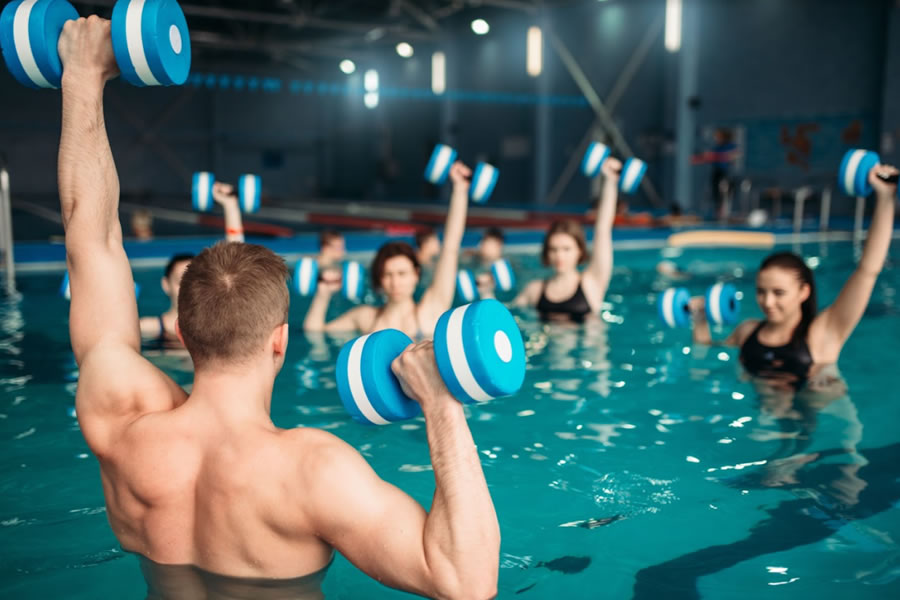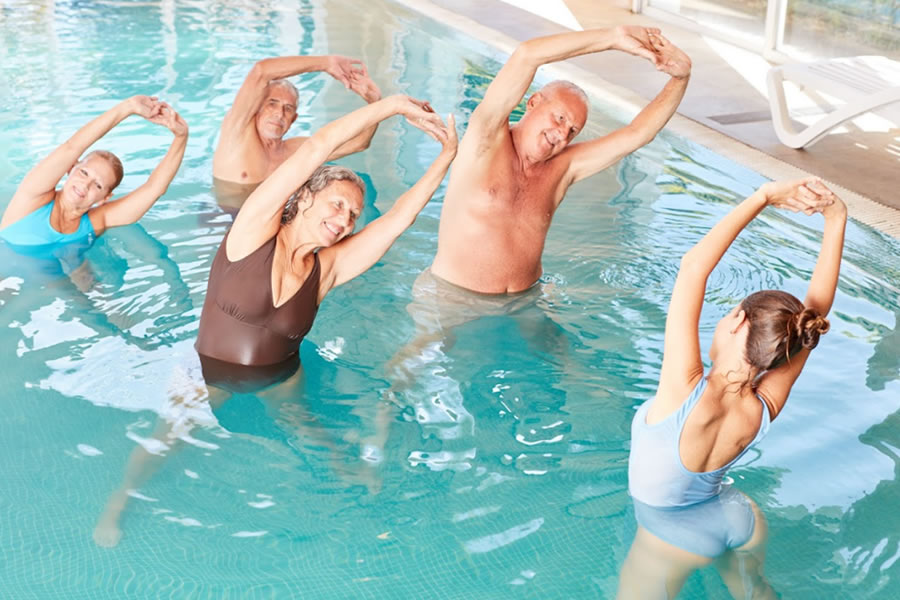🌎 Basic Guide To Working Out In The Pool

Aqua exercises may add variation to your usual workout routine. This type of exercise may keep you from getting bored and from flaking off your fitness regimen. It’s fun, equally (or more) challenging as land workouts, and can be performed together with a group of people.
Jimmy Minardi, personal trainer and creator of Minardi Training, stated that aqua exercises provide you the chance to work all major muscle groups without creating a harsh effect on your skeletal system. Every movement becomes a resistance exercise. This helps increases your overall fitness and enables you to reshape your body.
The Benefits of Pool Workouts
Water offers heavier resistance than air; hence, pool workouts can make the same land exercises more difficult. This form of resistance can aid in toning and strengthening those muscles. Aqua exercises may improve balance, flexibility, endurance, and cardiovascular fitness. Additionally, the heavy resistance may allow you to burn more calories in a short duration.
The water’s buoyancy aids support for your muscles and joints. For this reason, aqua exercises are regarded most suitable for people who are suffering from arthritis and fibromyalgia. It may also help improve the recovery process of those people who are experiencing other joint-related problems.
The Basic Guide to Pool Workouts
Before you get started, check out these basic when working out in the pool.
- Use the right swimming gear
The right gear will help you perform comfortably and effectively while working out in the pool. Remember, always prioritize functionality over fashion.
Aqua workouts that are performed in full ranges of motion and position may help you with your fitness and health. Apart from the usual activewear such as a swimming cap, a suit and water shoes to enhance traction, you may also need the following:
- Water dumbbells
If you prefer to add extra resistance, water weights may help you. These are buoyant dumbbells which makes it more challenging to submerge in the pool. They’re created using quick-drying EVA foam which keeps them super light during aqua workouts.
- Floatation belt
As you move from shallow to deep ends, floatation belts may cater the smooth transition. The weight from the belt may add benefit to your movement as you perform sprints.
- Wrist or ankle weights
While working out in the pool, these strap-on weights can add resistance to your arm and leg movements.
- Hand Paddles
Hand paddles are designed to provide you support in your early stroke movements. This helps you reach a high elbow position during workouts. This comes in different sizes and shapes. Some are also designed for various purposes other than this.
There are other swimming gears that may assist you in your pool workouts. Likewise, the device will depend with the type of activity you will be performing in the pool. You may head on to your nearest sports gear shop to find more of them.
- Try simple aqua workouts first
Before you attempt to do high-impact exercise, you may want to opt for the easy ones first. This may help you be more prepared and have more familiarity with the movements as you progress towards other exercises.
If you’ve practiced some of these movements in the gym already, you may focus less on your form and more on how you’d navigate through the water. Easy pool exercises such as walking in water, water arm lifts, and leg kicks may be recommended to those who are just starting out. Consider having a fitness coach around who will aid you in your performance and check if you’re executing the forms correctly.
- Stay hydrated
You may not seem to notice it, but you’re actually sweating a lot when doing aqua workouts. Whether you’re preparing to return to underwater sports or just working out for recreation, proper hydration is incredibly essential. It helps you with your performance and oxygen efficiency while doing a series of pool movements.
Drink lots of fluid before you start working out because you may forget to do so later on. Ideally, you should drink before, during, and after the workout. This will help reduce heat stress and maintain both normal body function and performance levels.
- Workout on an ideal pool temperature
The pool temperature matters because this affects your exercise duration and performance. This is why it’s important to determine how your body reacts to various water temperatures. This helps you avoid risky conditions while working out in the pool.
The ideal temperature range for moderate aquatic exercises is 83-88 degrees Fahrenheit. Bruce E. Becker, MD, a clinical professor at the University of Washington School of Medicine stated that your heart can function efficiently in this range. This is also the suitable temperature for individuals who are suffering from a cardiac condition.
- Comply with the pool rules
If you will be using a gym pool, follow the pool guidelines. This helps all pool-users have fun while staying safe. For instance, most gyms require you to shower ahead before you jump into the water. This may help maintain the pool’s cleanliness by washing off one’s body sweat and oil. Another common pool rule is to refrain from snacking while being in the pool.
The Bottom Line
Pool workouts encourage you to work out hard whilst placing minimum impact on your body. It may assist in healing, burn more calories, and helps you develop flexibility and strength. Pool workouts may be an enjoyable, new way of mixing up your usual workout regimen.
All the mentioned guidelines above may aid you to be effective as you maximize and perform various movements. Now, as you jump into the pool, have fun but remember that safety is also a priority.

Last Updated on December 15, 2020

